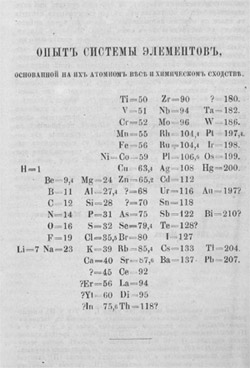|
What is Periodicity?
In studying the characteristics of various elements, the early chemists started to list various properties. John Dalton devised a means to determine a relative mass for the atoms of the elements. This would later allow us to arrange the elements in a table. This table, initially set up by the Russian scientist Dmitri Mendeleev, is the single most important tool of chemists everywhere in the world. In about 1868, Mendeleev arranged the 60 elements he knew of at the time in order of each element's increasing mass. This showed him a repeating pattern of other characteristics of the elements. The tendency to show a regular repeating pattern is known as periodicity.
Atomic Number
One important thing to note about Dmitri Mendeleev's first table is that there were blank spaces left. Mendeleev believed that there were elements yet undiscovered and actually predicted some of their properties based on their position in his table. Later, in 1913, Henry Moseley corrected some problems with the first table by rearranging the elements according to their atomic number rather than mass. You probably remember that the atomic number of an element is equal to the number of protons in the nuclei of its atoms. This rearrangement solved some irregularities in the periodicity of the original table, this new rearrangement of the Periodic Table of the Elements became rapidly accepted.
Ions and Isotopes
An ion is an atom in which the number of protons differs from the number of electrons. If an atom has more electrons than protons, the ion is known as an anion; if it has fewer electrons than protons, it is known as a cation. An isotope is an atom in which the number of protons and neutrons differ."
Importance of Protons
This orderly arrangement by number of protons makes sense on a basic level of logic. The number of electrons in an atom may be changed by adding or subtracting electrons to form positive or negative ions of the element. The number of neutrons in the nucleus of an atom may also be changed to create various isotopes of an element (some more stable than others). But add or subtract even one proton from an atom of any element and you no longer have the original element in any form. Now you have a different element! The number of protons in an atom determines what element it is.
Let's take a look at the Periodic Table.
|
